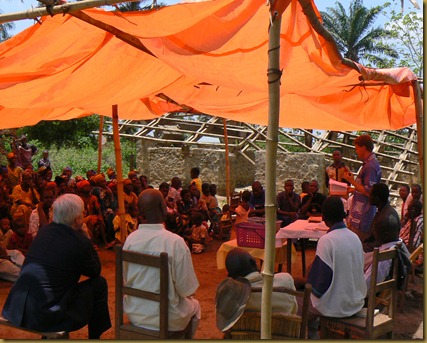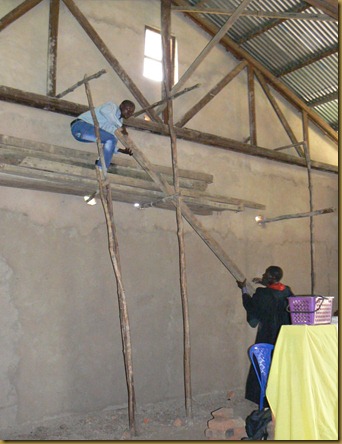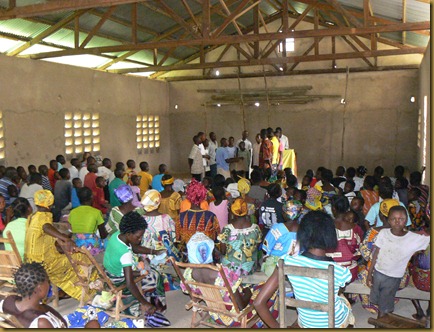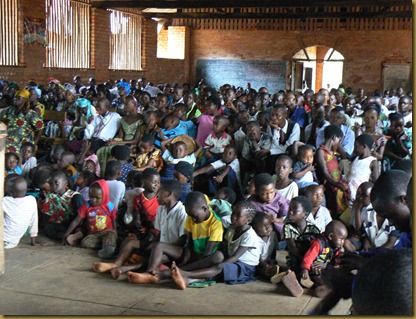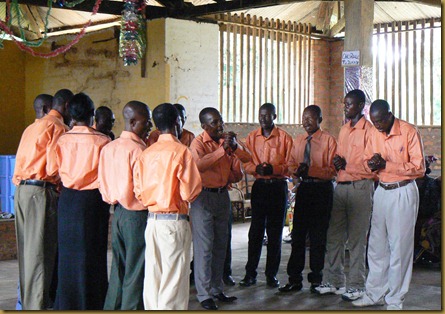Please join me today on my weekly shopping trip to town to pick up a few groceries and miscellaneous. You can imagine that shopping in Kananga is a little different than going to the store in the U.S., and rather than just generalize, I’ll try to help you experience with me this week’s outing. It is Tuesday afternoon at about 2:30, and today the sun is hot. So, I put on some sunscreen and take my big yellow umbrella to shade from the sun.

As I get to the end of our street, I greet Mamu Kapinga, one of the women who sells fruit on our corner. She has a few plantains today, and I remember that I need to get plantains for tomorrow’s dinner. I pay her for them (just before someone else asks for them!) and ask her to keep them for me until I come back. Mamu Marie sits next to Mamu Kapinga, and today she has some nice papaya. I greet her, purchase a papaya, and again ask her to keep it for me so that I don’t have extra weight to carry across town. It is nice to have these wonderful women so close who I can get fruit from!
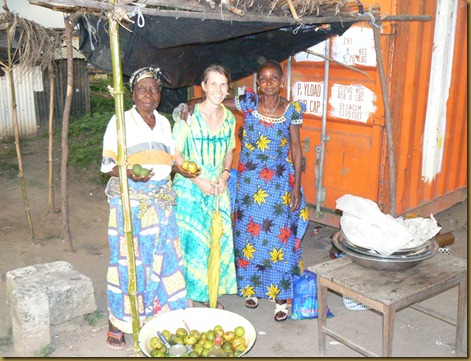
Mamu Marie (right) sells rice, peanuts, and fruit on the corner.
I walk about 1 more kilometer towards town, and pass by the fruit sellers in front of PAX, the clinic connected to CPC. There are a couple of long-necked squash. We love squash, but we still have half a squash at home and it is far to heavy for me to buy at the beginning of my outing. So, I continue on. I am in the middle of downtown now, and walk down the first block scanning the store fronts, looking for material for curtains for our office and a big plastic container to put in the fridge. I don’t see any good options, so decide to move on to the other things on my list. In the next block, I greet Mamu Kuupa Jackie, who has several large baskets of staple foods like rice, beans, onions, and potatoes set up on the sidewalk. “Did you go to Mutoto?” she asks. When I affirm that we did, she says excitedly “I saw a picture of you!” It turns out that she worships with some of the youth in the choir that traveled with us. Small world! I get a few kilos of onions and a kilo of beans, and then step into the hardware store behind her. I am looking for paint thinner, but not sure what they would call that here. “if you are painting, what do you use to clean the brush?” I ask in Tshiluba. “Tinnare” is the response. Of course! “thinner”, with a French accent! I learn the price, and make a mental note to get some next time.
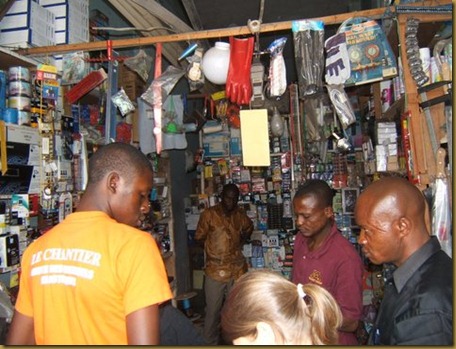 L-D Power
L-D Power
Kananga’s best hardware store
I start back up the street. On this street, venders sell vegetables displayed on plastic laid out on the sidewalk. This means that you have to carefully weave through the narrow space remaining for pedestrians. “No spinach today?”, I ask a few people. “Tomorrow”, is the response. I find some okra, and get a small bag that will hopefully last us the week.
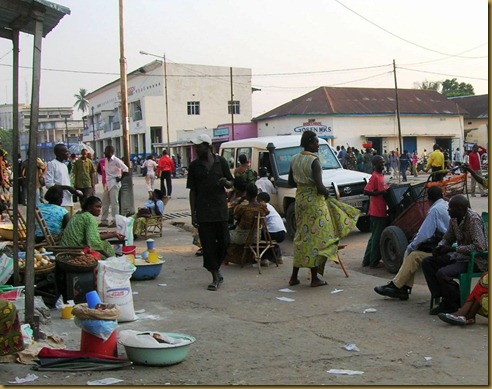 Avenue Mission, the main road in downtown Kananga –
Avenue Mission, the main road in downtown Kananga –
a mix of shops and sidewalk venders
In the next block, I stop into a small kiosk that sells office supplies. They don’t have the exacto-knife I’m looking for, but I get a roll of packing tape. I then go into a large (by Kananga standards) store that sells imported grocery items and household goods. Almost all stores in Kananga have a counter at the front where the clerk sits and transactions are made. The customer comes to the counter and tells the clerk the items he/she wants to purchase and pays the money (sometimes handing the money through a small hole in the mesh wire shield above the counter). Then the clerk or another employee collects the items and gives them to the customer. Perhaps similar to small-town grocery stores in the 40’s and 50’s in the U.S.? I greet the people at the counter, and purchase a can of milk powder and some instant coffee, but they are out of light bulbs. While I am there, Seur (Sister) Claudine, one of the nuns at the Thabor Catholic center, comes in. We exchange greetings while the clerk is collecting my purchases, and she asks when we will be coming next for a retreat. I was just there last week, but mention that Bob will probably be coming this month or next.
I leave the store, wondering what kind of store would sell light bulbs. I try the office supply kiosk, but they are out. I go on to Gosen, another “dry-goods” store across the street. Score! They have them! I buy a few light bulbs, and as they are handing them to me another customer or bystander admonishes the clerk that he should have put them in a plastic bag for me. “But plastic bags destroy the earth!” I argue, “I always shop with this big bag so that I avoid getting a plastic bag”. He doesn’t seem convinced, but at least the clerk, Jean de Dieu, is happy to accommodate me.
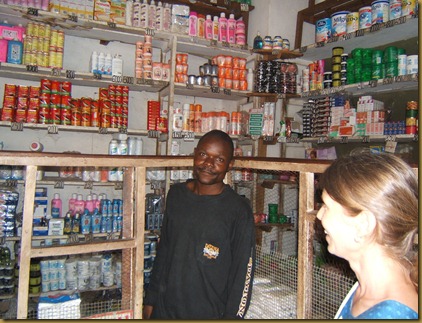
Jean de Dieu, the clerk in Gosen, standing in his store
I have most of the groceries on my list, and my bag is starting to get heavy. I head towards my last stop - picking up Bob’s suit-coat from the dry-cleaners. There is one drycleaner in Kananga, and this is the first time we are trying it out. This morning I drove to town to pick up a few boxes of Bibles, and tried to pick up the suit-coat on that trip while I had the vehicle. Unfortunately, the storefront where customers drop off and pick up clothes is not the same location where they do the cleaning. Despite the fact that it is Tuesday and they said it would be ready last Saturday, his coat was still in the other location and they asked that I return later in the day. When I reach the store now in the afternoon, I am tired from the heat and my heavy bag. The clerk tells me that Bob’s coat is still at the other location! I am frustrated, and tempted to criticize her – she told me in the morning that she would get the coat, and I had told her the time I would return. This is one of those “culture stress” moments, when I long for the efficiency and relative predictability of the U.S. Fortunately, a man walks in then who appears to be the boss of the dry-cleaners. He perceives the trouble, recognizes me, and makes a phone call to the other location. “Bring that coat over here! This pastor’s wife is standing here waiting. This is not good!” He offers me a chair, and in just a few minutes a man rides up on a motorcycle taxi with Bob’s suit-coat. That was an efficient resolution! I thank them for their help, and head towards home, trying to balance my bag, the umbrella, and the suit-coat.
On the way, I stop to chat with Pastor Tulume, who is sitting under a shade tree on the sidewalk. A little further on, I look for Mambuyi, the woman who gets water for us. She normally sells peanuts and biscuits at this intersection. Our barrel is nearly empty, and I want to ask her to come tomorrow to get water. I can’t find her, so continue towards home and find her husband at the corner where he works repairing bicycles and shoes. I greet him and congratulate them on his brother’s new baby. I ask him if Mambuyi came to the market today. “She did, but she has just left to go see the new baby.” I pass on the message to ask her to come tomorrow. One more block, and we are back on our street where I pick up my papaya and plantains from the women on the corner. “Wow! Did you buy a suit-coat for Bob?” they ask. I laugh, and explain that we just got his coat cleaned. I recognize an old and frail widow who attends the same parish we do, sitting next to Mamu Kapinga. She recognizes me and starts to excitedly declare “I know you! You attend the same parish I do! We are in the same church!” “Yes, yes. I know you, mother,” I say, trying to encourage her that I do recognize her. She asks for some money to buy food, and I give her a small amount that might help with a meal. I continue up the block, greeting the women who sell in the small market in front of our home. Just before reaching home, I buy a few tomatoes from a young girl who is filling in for her mother.
Whew! It is about 4:00 as I reach home. I am grateful to get some cold water and relax a few minutes after my long walk. Thanks for joining me - I hope that you enjoyed meeting some of the friendly faces around Kananga. Now – what do you think? Would you prefer to shop in Kananga, or in the town where you live? Any particular differences of shopping here you like or would struggle with?
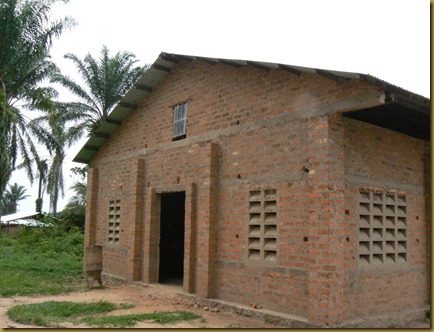 February, 2013: Second phase of construction completed
February, 2013: Second phase of construction completed
